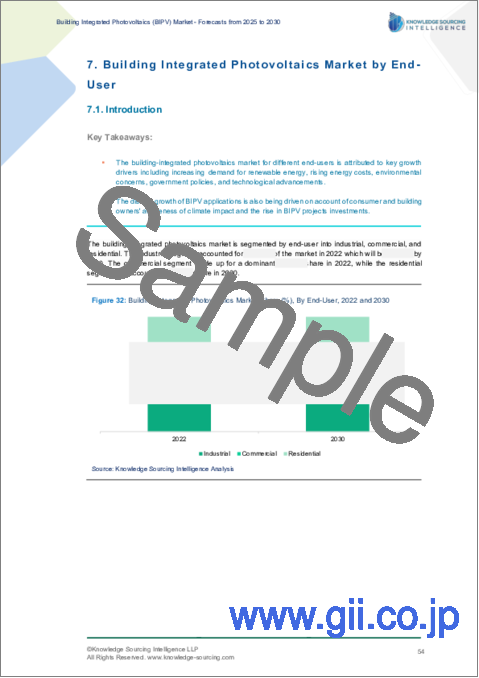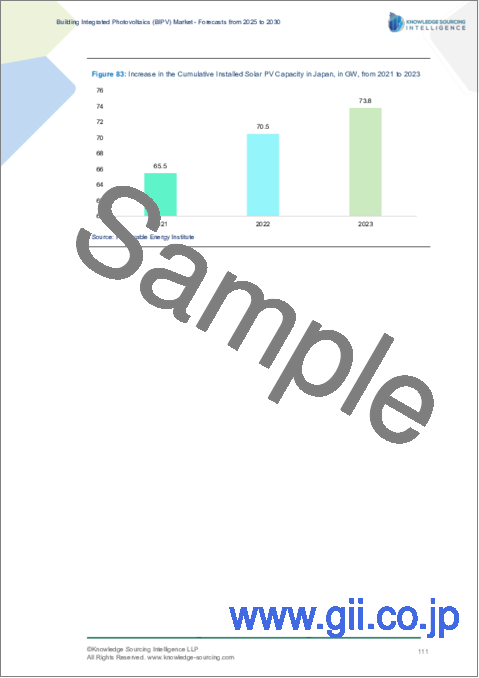|
|
市場調査レポート
商品コード
1649527
建物一体型太陽光発電市場:予測(2025年~2030年)Building Integrated Photovoltaics Market - Forecasts from 2025 to 2030 |
||||||
カスタマイズ可能
|
|||||||
| 建物一体型太陽光発電市場:予測(2025年~2030年) |
|
出版日: 2025年01月13日
発行: Knowledge Sourcing Intelligence
ページ情報: 英文 142 Pages
納期: 即日から翌営業日
|
全表示
- 概要
- 目次
建物一体型太陽光発電市場は予測期間中にCAGR12.63%で成長し、2025年の69億1,000万米ドルから、2030年までには125億2,600万米ドルに拡大すると予測されています。
太陽光発電(PV)技術は太陽光を電気エネルギーに変換する技術であり、建物一体型太陽光発電(BIPV)は特に、屋根、ファサード、天窓といった従来の建築部材に代わって発電するPV材料を指します。BIPVソリューションは、太陽エネルギー発電を促進するだけでなく、建物の二酸化炭素排出量削減にも貢献します。BIPV市場は、主に住宅分野でのPV技術採用の増加により、大きな成長を遂げています。米国立再生可能エネルギー研究所(NREL)は、カリフォルニア州におけるBIPV技術の独立型および蓄電型ソリューションの住宅導入が大幅に伸びており、2022年には設置量が8.9MWdcに達すると報告しています。2020年から2022年の間に、住宅用BIPVの設置は約140%増加し、その間に同州で新たに設置された住宅用BIPVのほぼすべてをTeslaが占めました。
建物一体型太陽光発電市場の促進要因:
- 太陽光発電技術の採用拡大:太陽光発電技術は、持続可能で再生可能なエネルギー源、特に太陽エネルギーへの消費者の選好の変化により、世界的に大きく成長しています。消費者の選好が変化するにつれて、BIPV技術を含む太陽エネルギーソリューションに対する需要が急増しています。また、世界各国の有利な政府政策や補助金制度も、太陽光発電の導入促進に重要な役割を果たしています。SolarPower Europeによると、2023年のPV年間設置容量は世界全体で87%増加し、2022年の239GWから447GWに達しました。最大の太陽光発電市場は中国と米国で、設置容量はそれぞれ2億5,300万kWと3,240万kWです。
建物一体型太陽光発電市場を形成する地理的動向:
- 北米が市場シェアをリードする見通し:北米は予測期間中、建物一体型太陽光発電市場で大きなシェアを占めると予測されています。この地域の成長の主な要因は、再生可能エネルギーソリューションに対する需要の増加、政府のインセンティブ、持続可能性への関心の高まりです。米国市場が特に堅調なのは、肥満率の上昇によって消費者がスポーツジムの会員になり、より健康的なライフスタイルを志向しているためです。国際エネルギー機関(IEA)は、2023年から2028年の間に再生可能エネルギーによる発電容量が337.1GWから2017年から2022年の156.6GWに増加すると予測しています。
税額控除やリベートといった連邦や州のインセンティブにより、BIPVシステムは消費者にとってより手頃な価格になっています。例えば、2022年8月に導入されたインフレ削減法(IRA)は、ローン・プログラム・オフィス(LPO)を通じて新たな融資を創出するために確保された117億米ドルを含む様々な金融優遇措置を通じて、今後10年間で再生可能エネルギーへの資金を大幅に増強することを目指しています。アジア太平洋もまた、天然素材やオーガニック製品に対する意識の高まりから、この期間に大幅な成長が見込まれています。可処分所得が増加する中産階級人口の増加は、市場拡大に有利な環境を作り出しています。まとめると、建物一体型太陽光発電市場は、持続可能なエネルギーソリューションに対する消費者の選好の高まり、環境への影響に対する意識の高まり、再生可能エネルギーの採用を促進する政府の支援政策、この拡大する市場展望を強化する北米を中心とした実質的な市場開拓によって、大きな成長が見込まれています。
本レポートを購入する理由
- 洞察に満ちた分析:顧客セグメント、政府政策と社会経済要因、消費者選好、産業別、その他のサブセグメントに焦点を当て、主要地域および新興地域を網羅する詳細な市場考察を得ることができます。
- 競合情勢:世界の主要企業が採用している戦略的策略を理解し、適切な戦略による市場浸透の可能性を理解することができます。
- 市場動向と促進要因:ダイナミックな要因と極めて重要な市場動向、そしてそれらが今後の市場展開をどのように形成していくかを探ります。
- 実行可能な提言:ダイナミックな環境の中で新たなビジネスストリームと収益を発掘するための戦略的決断を下すために、洞察を活用します。
- 幅広い利用者に対応:新興企業、研究機関、コンサルタント、中小企業、大企業にとって有益で費用対効果に優れています。
どのような用途で利用されていますか?
業界と市場考察、事業機会評価、製品需要予測、市場参入戦略、地理的拡大、設備投資の決定、規制の枠組みと影響、新製品開拓、競合の影響
調査範囲
- 2022年から2030年までの実績データと予測
- 成長機会、課題、サプライチェーンの展望、規制枠組み、顧客行動、動向分析
- 競合のポジショニング、戦略、市場シェア分析
- 収益の成長と予測国々を含むセグメントおよび地域の分析
- 企業プロファイリング(戦略、製品、財務状況、主な発展など)
建物一体型太陽光発電市場は以下のようにセグメント化されています:
技術別
- 結晶性シリコーン
- 薄膜
- その他
用途別
- 屋根
- ファサード
- その他
エンドユーザー別
- 産業用
- 商業用
- 住宅用
地域別
- 北米
- 米国
- カナダ
- メキシコ
- 南米
- ブラジル
- アルゼンチン
- その他
- 欧州
- 英国
- ドイツ
- フランス
- スペイン
- イタリア
- その他
- 中東・アフリカ
- サウジアラビア
- UAE
- イスラエル
- その他
- アジア太平洋
- 日本
- 中国
- インド
- 韓国
- インドネシア
- タイ
- 台湾
- その他
目次
第1章 イントロダクション
- 市場概要
- 市場の定義
- 調査範囲
- 市場セグメンテーション
- 通貨
- 前提条件
- 基準年と予測年のタイムライン
- 利害関係者にとっての主なメリット
第2章 調査手法
- 調査デザイン
- 調査プロセス
第3章 エグゼクティブサマリー
- 主な調査結果
第4章 市場力学
- 市場促進要因
- 市場抑制要因
- ポーターのファイブフォース分析
- 業界バリューチェーン分析
- アナリストビュー
第5章 建物一体型太陽光発電市場:技術別
- イントロダクション
- 結晶性シリコン
- 薄膜
- その他
第6章 建物一体型太陽光発電市場:用途別
- イントロダクション
- 屋根
- ファサード
- その他
第7章 建物一体型太陽光発電市場:エンドユーザー別
- イントロダクション
- 産業用
- 商業用
- 住宅用
第8章 建物一体型太陽光発電市場:地域別
- イントロダクション
- 北米
- 技術別
- 用途別
- エンドユーザー別
- 国別
- 南米
- 技術別
- 用途別
- エンドユーザー別
- 国別
- 欧州
- 技術別
- 用途別
- エンドユーザー別
- 国別
- 中東・アフリカ
- 技術別
- 用途別
- エンドユーザー別
- 国別
- アジア太平洋
- 技術別
- 用途別
- エンドユーザー別
- 国別
第9章 競合環境と分析
- 主要企業と戦略分析
- 市場シェア分析
- 合併、買収、合意、コラボレーション
- 競合ダッシュボード
第10章 企業プロファイル
- TrinaSolar Co., Ltd.
- Kaneka Energy Management Solutions
- Onyx Solar Group LLC
- AGC
- Solarday
- Mitrex
- Polysolar
- Kyocera
- MetSolar
- SunTegra Solar
- Novergy Energy Solutions Pvt. Ltd.
- Waaree Energies Ltd.
- SolarScape Enterprises LLP.
- LONGi
- Jinko Solar
The building integrated photovoltaics market is projected to grow at a CAGR of 12.63% over the forecast period, increasing from US$6.910 billion in 2025 to US$12.526 billion by 2030.
Photovoltaics (PV) technology converts sunlight into electrical energy, and building-integrated photovoltaics (BIPV) specifically refers to PV materials that replace traditional building components like roofs, facades, and skylights to generate electricity. BIPV solutions not only facilitate solar energy generation but also contribute to reducing the carbon footprint of buildings.The market for BIPV is experiencing significant growth, driven primarily by the increasing adoption of PV technology in the residential sector. The National Renewable Energy Laboratory (NREL) reported substantial growth in the residential adoption of standalone and storage solutions of BIPV technology in California, where installations reached 8.9 MWdc in 2022. Between 2020 and 2022, residential BIPV installations grew by approximately 140%, with Tesla accounting for nearly all new residential BIPV installations in the state during that time.
Drivers of the Building Integrated Photovoltaics Market:
- Increasing Adoption of Photovoltaic Technology: The global uptake of photovoltaic technology has seen significant growth, driven by a shift in consumer preferences toward sustainable and renewable energy sources, particularly solar energy. As consumer preferences evolve, the demand for solar energy solutions, including BIPV technology, has surged. Favorable government policies and subsidy schemes worldwide have also played a crucial role in promoting the adoption of photovoltaics. According to SolarPower Europe, annual PV installation capacity increased by 87% globally in 2023, reaching 447 GW compared to 239 GW in 2022. China and the USA emerged as the largest solar markets with installed capacities of 253 GW and 32.4 GW, respectively.
Geographical Trends Shaping the Building Integrated Photovoltaics Market:
- North America Expected to Lead Market Share: North America is projected to hold a significant share of the building-integrated photovoltaics market during the forecast period. The growth in this region is primarily attributed to increasing demand for renewable energy solutions, government incentives, and a heightened focus on sustainability. The U.S. market is particularly robust due to rising obesity rates driving consumers toward gym memberships and healthier lifestyles. The International Energy Agency (IEA) has projected an increase in renewable electricity capacity from 337.1 GW between 2023-2028 compared to 156.6 GW from 2017-2022.
Federal and state incentives such as tax credits and rebates have made BIPV systems more affordable for consumers. For instance, the Inflation Reduction Act (IRA), introduced in August 2022, aims to significantly boost funding for renewable energy over the next decade through various financial incentives, including $11.7 billion reserved for creating new loans via the Loan Programs Office (LPO). This has made utility-scale solar PV projects more accessible within the national energy mix.The Asia-Pacific region is also expected to experience substantial growth during this period due to increasing awareness of natural and organic products. The growing middle-class population with rising disposable income is creating a favorable environment for market expansion. Countries such as South Korea, Japan, China, Thailand, and India are developing their aesthetic industries, driving demand for innovative healthcare technologies like neuro-navigation systems.In summary, the building integrated photovoltaics market is set for significant growth driven by rising consumer preferences for sustainable energy solutions, increased awareness about environmental impacts, supportive government policies promoting renewable energy adoption, and substantial geographical developments-particularly within North America-that enhance this expanding market landscape.
Reasons for buying this report:-
- Insightful Analysis: Gain detailed market insights covering major as well as emerging geographical regions, focusing on customer segments, government policies and socio-economic factors, consumer preferences, industry verticals, other sub- segments.
- Competitive Landscape: Understand the strategic maneuvers employed by key players globally to understand possible market penetration with the correct strategy.
- Market Drivers & Future Trends: Explore the dynamic factors and pivotal market trends and how they will shape up future market developments.
- Actionable Recommendations: Utilize the insights to exercise strategic decision to uncover new business streams and revenues in a dynamic environment.
- Caters to a Wide Audience: Beneficial and cost-effective for startups, research institutions, consultants, SMEs, and large enterprises.
What do businesses use our reports for?
Industry and Market Insights, Opportunity Assessment, Product Demand Forecasting, Market Entry Strategy, Geographical Expansion, Capital Investment Decisions, Regulatory Framework & Implications, New Product Development, Competitive Intelligence
Report Coverage:
- Historical data & forecasts from 2022 to 2030
- Growth Opportunities, Challenges, Supply Chain Outlook, Regulatory Framework, Customer Behaviour, and Trend Analysis
- Competitive Positioning, Strategies, and Market Share Analysis
- Revenue Growth and Forecast Assessment of segments and regions including countries
- Company Profiling (Strategies, Products, Financial Information, and Key Developments among others)
The building integrated photovoltaics market has been segmented as following:
By Technology
- Crystalline Silicone
- Thin Film
- Others
By Application
- Roof
- Facades
- Others
By End-User
- Industrial
- Commercial
- Residential
By Geography
- North America
- United States
- Canada
- Mexico
- South America
- Brazil
- Argentina
- Others
- Europe
- United Kingdom
- Germany
- France
- Spain
- Italy
- Others
- Middle East and Africa
- Saudi Arabia
- UAE
- Israel
- Others
- Asia Pacific Region
- Japan
- China
- India
- South Korea
- Indonesia
- Thailand
- Taiwan
- Others
TABLE OF CONTENTS
1. INTRODUCTION
- 1.1. Market Overview
- 1.2. Market Definition
- 1.3. Scope of the Study
- 1.4. Market Segmentation
- 1.5. Currency
- 1.6. Assumptions
- 1.7. Base and Forecast Years Timeline
- 1.8. Key benefits for the stakeholders
2. RESEARCH METHODOLOGY
- 2.1. Research Design
- 2.2. Research Process
3. EXECUTIVE SUMMARY
- 3.1. Key Findings
4. MARKET DYNAMICS
- 4.1. Market Drivers
- 4.2. Market Restraints
- 4.3. Porter's Five Forces Analysis
- 4.3.1. Bargaining Power of Suppliers
- 4.3.2. Bargaining Power of Buyers
- 4.3.3. The Threat of New Entrants
- 4.3.4. Threat of Substitutes
- 4.3.5. Competitive Rivalry in the Industry
- 4.4. Industry Value Chain Analysis
- 4.5. Analyst View
5. BUILDING INTEGRATED PHOTOVOLTAICS MARKET BY TECHNOLOGY
- 5.1. Introduction
- 5.2. Crystalline Silicone
- 5.3. Thin Film
- 5.4. Others
6. BUILDING INTEGRATED PHOTOVOLTAICS MARKET BY APPLICATION
- 6.1. Introduction
- 6.2. Roof
- 6.3. Facades
- 6.4. Others
7. BUILDING INTEGRATED PHOTOVOLTAICS MARKET BY END-USER
- 7.1. Introduction
- 7.2. Industrial
- 7.3. Commercial
- 7.4. Residential
8. BUILDING INTEGRATED PHOTOVOLTAICS MARKET BY GEOGRAPHY
- 8.1. Introduction
- 8.2. North America
- 8.2.1. By Technology
- 8.2.2. By Application
- 8.2.3. By End-User
- 8.2.4. By Country
- 8.2.4.1. United States
- 8.2.4.2. Canada
- 8.2.4.3. Mexico
- 8.3. South America
- 8.3.1. By Technology
- 8.3.2. By Application
- 8.3.3. By End-User
- 8.3.4. By Country
- 8.3.4.1. Brazil
- 8.3.4.2. Argentina
- 8.3.4.3. Others
- 8.4. Europe
- 8.4.1. By Technology
- 8.4.2. By Application
- 8.4.3. By End-User
- 8.4.4. By Country
- 8.4.4.1. United Kingdom
- 8.4.4.2. France
- 8.4.4.3. Germany
- 8.4.4.4. Spain
- 8.4.4.5. Italy
- 8.4.4.6. Others
- 8.5. Middle East and Africa
- 8.5.1. By Technology
- 8.5.2. By Application
- 8.5.3. By End-User
- 8.5.4. By Country
- 8.5.4.1. Saudi Arabia
- 8.5.4.2. UAE
- 8.5.4.3. Israel
- 8.5.4.4. Others
- 8.6. Asia Pacific
- 8.6.1. By Technology
- 8.6.2. By Application
- 8.6.3. By End-User
- 8.6.4. By Country
- 8.6.4.1. Japan
- 8.6.4.2. China
- 8.6.4.3. India
- 8.6.4.4. South Korea
- 8.6.4.5. Indonesia
- 8.6.4.6. Thailand
- 8.6.4.7. Taiwan
- 8.6.4.8. Others
9. COMPETITIVE ENVIRONMENT AND ANALYSIS
- 9.1. Major Players and Strategy Analysis
- 9.2. Market Share Analysis
- 9.3. Mergers, Acquisitions, Agreements, and Collaborations
- 9.4. Competitive Dashboard
10. COMPANY PROFILES
- 10.1. TrinaSolar Co., Ltd.
- 10.2. Kaneka Energy Management Solutions
- 10.3. Onyx Solar Group LLC
- 10.4. AGC
- 10.5. Solarday
- 10.6. Mitrex
- 10.7. Polysolar
- 10.8. Kyocera
- 10.9. MetSolar
- 10.10. SunTegra Solar
- 10.11. Novergy Energy Solutions Pvt. Ltd.
- 10.12. Waaree Energies Ltd.
- 10.13. SolarScape Enterprises LLP.
- 10.14. LONGi
- 10.15. Jinko Solar





